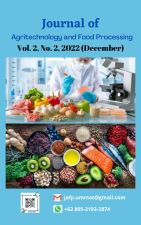Addition of rosella flower (Hibiscus sabdariffa) powder addition on the quality of bulk cooking oil
DOI:
https://doi.org/10.31764/jafp.v2i2.12405Keywords:
antioxidants, fatty acid, cooking oil, peroxidesAbstract
Oil is used as a medium for frying food that is widely consumed by the public. One way to overcome rancidity by improving the quality of oil by using antioxidants. Antioxidants consist of synthetic antioxidants and natural antioxidants. The use of synthetic antioxidants such as BHA (Butyl Hydroxy Anisol) and BHT (Butyl Hydroxy Toulene) raises many concerns about side effects such as causing swelling of the liver and affecting enzyme activity. Therefore, it is necessary to look for other alternatives, namely natural antioxidants. Natural antioxidants are antioxidants extracted from natural plant and microbial materials. One of the plants that has the potential to be utilized as a natural antioxidant is Rosella Flower. This aims of this study was to determine the effect of adding rosella flower powder as a natural antioxidant and to determine the quality of bulk cooking oil after adding Rosella Flower Powder to bulk cooking oil stored for 0 and 7 days. This study uses the Iodometric Titration method, data obtained by statistical tests and comparison with Indonesian National Standard number 01-3741-2013. The results of the analysis with Post hoc LSD test showed that the use of rosella flower powder almost equaled BHT and was said to be one group.
References
Alfira, A. 2014. Uji Aktivitas Antioksidan Ekstrak dan Fraksi Aktif Kulit Batang Sintok. Skripsi. Jakarta: UIN Syarif Hidayatullah.
Badan Standart Nasional – SNI – 3741 – 2013 (Standart Mutu Minyak dan Lemak). Badan Standarisasi Nasional : Jakarta
Dwiyanti, G., & Nuraeni, H. 2014. aktivitas Antioksidan Teh Rosella (Hibiscus sabdarifa) Selama Penyimpanan dan Suhu Ruang. Seminar: Prosding Seminar Nasional Sains Dan Pendidikan Sains, 5(1).
Fardani, Roushandy, 2018. Pengaruh Penambahan Bubuk Bawang Merah Terhadap Bilangan peroksida Pada Minyak Goreng Curah. Media Of Medical Laboratory Sciene Vol. 2 (1) Hal. 35
Inggrid, M., Hartanto, Y., & Widjaja, J. F. (2018). Karakteristik Antioksidan pada Kelopak Bunga Rosella (Hibiscus sabdariffa Linn.). Rekayasa Hijau: Jurnal Teknologi Ramah Lingkungan, 2(3).
Komayaharti, A., & Paryanti, D. (2009). Ekstrak Daun Sirih Sebagai Antioksidan Pada Minyak Kelapa.
Nainggolan, B., Susanti, N., & Juniar, A. (2016). Uji kelayakan minyak goreng curah dan kemasan yang digunakan menggoreng secara berulang. Jurnal Pendidikan Kimia, 8(1), 45–antiy57.
Nurrahmah, A., & Putri, S. R. F. Y. (2020). Analisis Perbandingan Penggunaan Minyak Curah Dan Minyak Kemasan Menggunakan Uji Hipotesis Dua Proporsi. Bulletin of Applied Industrial Engineering Theory, 1(2).
Panagan, T. A. (2010). Pengaruh penambahan bubuk bawang merah (allium ascalonicum) terhadap bilangan peroksida dan kadar asam lemak bebas minyak goreng curah. Universitas Sriwijaya, Palembang, 6(5), 17–19.
Paramitha, Andi Reski A. 2012. Studi Kualitas Minyak Makanan Gorengan Pada Penggunaan Minyak Goreng Berulang. Skripsi, Universitas Hasanudin, Makasar.
Purwaningsih, D. Y., Zuchrilah, D. R., & Nurmala, I. (2019). Peningkatkan Mutu Minyak Goreng Curah dengan Penambahan Ekstrak Kulit Pisang Raja Sebagai Antioksidan Alami. Reka Buana: Jurnal Ilmiah Teknik Sipil Dan Teknik Kimia, 4(1), 22–29.
Rohman, Abdul. 2016. Lipid Sifat Fisika Kimia dan Analisisnya. Pustaka Pelajar (Anggota IKAPI) : Yogyakarta.
Winarno, F.G. 2016. Kimia Pangan dan Gizi. PT. Gramedia Pustaka Utama : Jakarta
Yoshimoto, M., Yahara, S., Okuno, S., Islam, M. S., Ishiguro, K., & Yamakawa, O. (2002). Antimutagenicity of mono-, di-, and tricaffeoylquinic acid derivatives isolated from sweetpotato (Ipomoea batatas L.) leaf. Bioscience, Biotechnology, and Biochemistry, 66(11), 2336–2341.
Downloads
Published
Issue
Section
License
Authors who publish with this journal agree to the following terms:
1. Authors retain copyright and grant the journal right of first publication with the work simultaneously licensed under a Creative Commons Attribution License that allows others to share the work with an acknowledgement of the work's authorship and initial publication in this journal.
2. Authors are able to enter into separate, additional contractual arrangements for the non-exclusive distribution of the journal's published version of the work (e.g., post it to an institutional repository or publish it in a book), with an acknowledgement of its initial publication in this journal.
3. Authors are permitted and encouraged to post their work online (e.g., in institutional repositories or on their website) prior to and during the submission process, as it can lead to productive exchanges, as well as earlier and greater citation of published work (See The Effect of Open Access).

